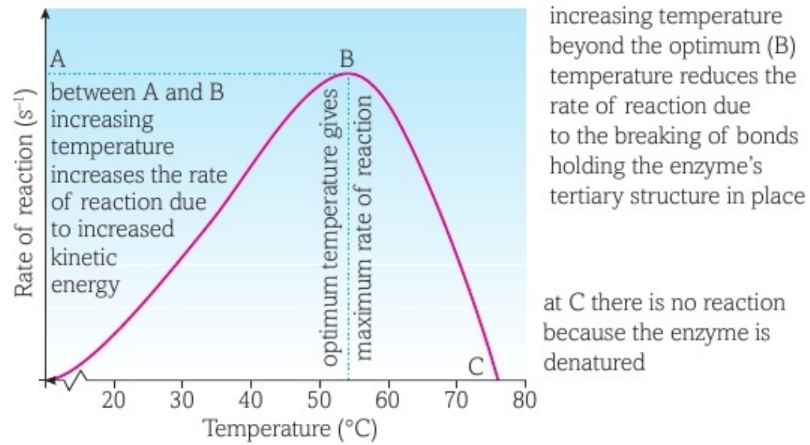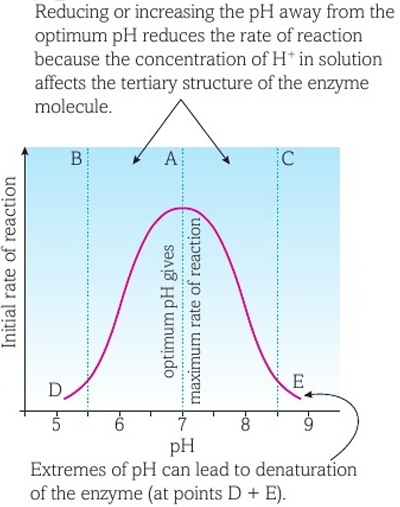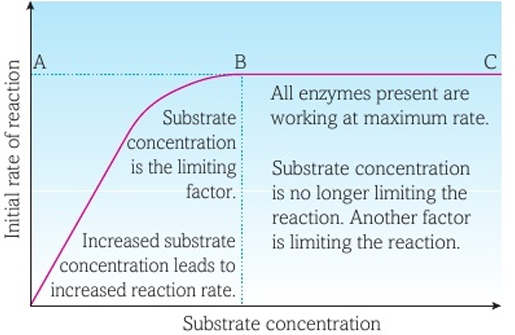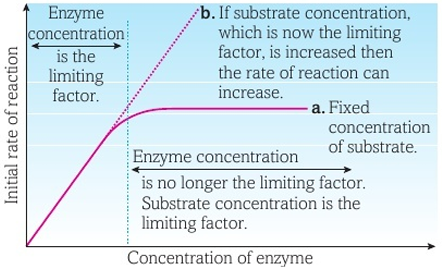
Factors affecting Enzyme Activity
4 Factors that affect enzyme activity are:
Temperature
pH
Substrate conc.
Enzyme conc.
Temperature:
Increase in temp. leads to increase in Ek which leads to increased rate of successful collisions between substrate and enzyme molecules. This leads to more ESC’s forming, leading to increase in product.
If temp. is too low, insufficient Ek for successful collisions, thus less ESC’s form, thus less product is prod.
If temp. is too high, enzymes denature, bonds that hold 3o of enzyme begin to break thus irreversibly changing the shape of the active site, making it no longer complementary to the specific substrate, making it unable to form ESC’s and unable to catalyse the specific reaction.
Optimum Temp. = temp. that gives max. rate of reaction

Temp. Coefficient, Q10 :

Q10 value is usually roughly 2 upto the optimum temp. However for temps above optimum point Q10 value decreases.
pH:
Extreme values of pH, whether high or low, interfere with the charges of amino acid at the active site disrupting the enzymes 3o thus changing the shape of the active site, leading to enzyme being unable to form ESC’s w/ specific substrate.
Small changes on either side of optimum pH slow the rate of reaction, due to active site being altered, however if optimum pH is restored, H bonds can reform and active site can be restored.
On the other hand, at extremes of pH, enzyme’s active site can be irreversibly altered thus leading to it becoming denatured.
Buffer = molecule that counters change in pH, by either accepting or donating protons.

Enzymes have diff. optimum pH values dependent on where they work, however, generally, intracellular enzymes have optimum pH values close to 7, and extracellular enzyme optimum pH values vary dependent on where they work. (Notable egs. include: pepsin, which breaks down protein molecules in the stomach thus having a lower optimum pH around 1-2 and trypsin which breaks down peptides into amino acids in the small intestine with a slightly alkaline optimum pH around 7.8. )
Substrate Conc.
At low substrate conc. rate of reaction will be low as fewer successful collisions between enzymes and subs. thus less ESC’s form etc. (Substrate conc. is limiting)
Increasing substrate conc. leads to increase in rate of reaction as more substrates will bind to available active sites, thus more ESC’s form.
At high substrate conc. rate of reaction plateaus due to all active sites being in use. (enzymes fully saturated, substrate conc. no longer limiting.)

Enzyme Conc.
At low enzyme conc. rate of reaction will be low due to less active sites readily available for substrates to bind to, thus decreasing amount of ESC’s formed. (Enzyme conc. is limiting)
Increasing enzyme conc. leads to increase in rate of reaction as more active sites available for substrates to bind to, thus more ESC’s form.
At high enzyme conc. rate of reaction plateaus as there will be insufficient amount of substrate to bind with large no. of enzymes. (Enzyme conc. is no longer limiting)
However if substrate conc. is unlimited, then rate of reaction will continue to increase.

Factors affecting Enzyme Activity
4 Factors that affect enzyme activity are:
Temperature
pH
Substrate conc.
Enzyme conc.
Temperature:
Increase in temp. leads to increase in Ek which leads to increased rate of successful collisions between substrate and enzyme molecules. This leads to more ESC’s forming, leading to increase in product.
If temp. is too low, insufficient Ek for successful collisions, thus less ESC’s form, thus less product is prod.
If temp. is too high, enzymes denature, bonds that hold 3o of enzyme begin to break thus irreversibly changing the shape of the active site, making it no longer complementary to the specific substrate, making it unable to form ESC’s and unable to catalyse the specific reaction.
Optimum Temp. = temp. that gives max. rate of reaction

Temp. Coefficient, Q10 :

Q10 value is usually roughly 2 upto the optimum temp. However for temps above optimum point Q10 value decreases.
pH:
Extreme values of pH, whether high or low, interfere with the charges of amino acid at the active site disrupting the enzymes 3o thus changing the shape of the active site, leading to enzyme being unable to form ESC’s w/ specific substrate.
Small changes on either side of optimum pH slow the rate of reaction, due to active site being altered, however if optimum pH is restored, H bonds can reform and active site can be restored.
On the other hand, at extremes of pH, enzyme’s active site can be irreversibly altered thus leading to it becoming denatured.
Buffer = molecule that counters change in pH, by either accepting or donating protons.

Enzymes have diff. optimum pH values dependent on where they work, however, generally, intracellular enzymes have optimum pH values close to 7, and extracellular enzyme optimum pH values vary dependent on where they work. (Notable egs. include: pepsin, which breaks down protein molecules in the stomach thus having a lower optimum pH around 1-2 and trypsin which breaks down peptides into amino acids in the small intestine with a slightly alkaline optimum pH around 7.8. )
Substrate Conc.
At low substrate conc. rate of reaction will be low as fewer successful collisions between enzymes and subs. thus less ESC’s form etc. (Substrate conc. is limiting)
Increasing substrate conc. leads to increase in rate of reaction as more substrates will bind to available active sites, thus more ESC’s form.
At high substrate conc. rate of reaction plateaus due to all active sites being in use. (enzymes fully saturated, substrate conc. no longer limiting.)

Enzyme Conc.
At low enzyme conc. rate of reaction will be low due to less active sites readily available for substrates to bind to, thus decreasing amount of ESC’s formed. (Enzyme conc. is limiting)
Increasing enzyme conc. leads to increase in rate of reaction as more active sites available for substrates to bind to, thus more ESC’s form.
At high enzyme conc. rate of reaction plateaus as there will be insufficient amount of substrate to bind with large no. of enzymes. (Enzyme conc. is no longer limiting)
However if substrate conc. is unlimited, then rate of reaction will continue to increase.

 Knowt
Knowt